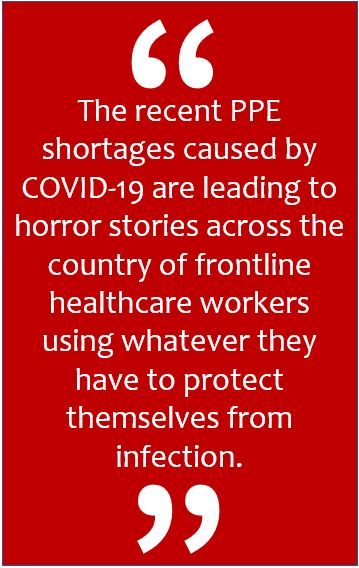What is the Evidence on Improvised PPE?
Improvised PPE suggested or used against COVID-19 include ski goggles, scuba masks, motorcycles helmets, and band-aids. Does any of it work?
<br/>JAMA readers suggest or report using ski goggles, scuba masks, and even motorcycles helmets as PPE. (©mustgo/stock.adobe.com)


The recent PPE shortages caused by COVID-19 are leading to horror stories across the country of frontline healthcare workers using whatever they have to protect themselves from infection. I recently read a piece describing an ER physician who had been using his ski goggles as eye protection because the hospitals he covered had nothing else for him to use.
Here, we’ll take a look at the available evidence for some of the most commonly mentioned improvised PPE.
Ski Goggles, Scuba Masks, More
A recent article in JAMA, which summarizes over 250 comments received about improvised PPE, shows that many readers have either used or suggested the use of ski goggles, scuba masks, and even motorcycles helmets and band-aids to cover up your nostrils. There is limited to no evidence for the effectiveness of any of these in preventing transmission, though a WHO white paper recommends that healthcare workers wear ‘goggles,’ without providing further clarification. Certainly, ski goggles could reasonably fit into this category, but probably not the bandaged nostrils!
Homemade Masks
Homemade, cloth masks are some of the most talked-about alternative PPE items, with companies and individuals all over the country pitching in to make them and help alleviate hospital shortages of surgical masks and N95 respirators.
Do they work though?Unfortunately, the evidence is mixed.
One now widely-read study published in the BMJ in 2015 looked at homemade mask use across 14 secondary and tertiary hospitals in Vietnam. Healthcare workers were assigned to a homemade mask, a surgical mask, or no mask. The primary end point was clinical respiratory illness, influenza like illness, or laboratory-confirmed viral respiratory infection. They found not only that penetration was 97% for homemade masks, but that they might actually increase the risk of infection. In response to queries about those results in light of the COVID-19 outbreak, the authors wrote additional commentary published March 30, 2020 that is recommended reading for anyone looking at this study.
A much smaller study of 21 people looked at the potential for masks made out of cotton t-shirts in preventing the spread of microorganisms. All volunteers were healthy and coughed into the masks, then samples were collected and compared to surgical masks and no mask. They found that the cotton t-shirt masks reduced the number of microorganisms, but to a much less extent than a surgical mask.
One critical weakness in this study, other than the fact it was a small number of individuals, is that all the volunteers were healthy and thus the microorganisms collected were mostly likely normal oral, bacterial flora. Since a virus, like influenza or COVID, is much smaller, it remains to be seen whether a cotton t-shirt would prevent transmission at all. This study was also more of a theoretical study and did not tie homemade mask use to a hard outcome, like incidence of new viral infection cases.
Reuse of Single-use PPE
In times of desperation and forced to choose between homemade PPE and no PPE, many hospitals and healthcare providers are reusing single-use PPE. While certainly not ideal nor recommended, efforts have been made to find ways to safely reuse them.
A
reportby the European Centre for Disease Prevention and Control, Europe’s CDC equivalent, provides an excellent summary of the situation and any available evidence. In it, they cite a report from the US National Academy of Sciences on the possibility of reusing single-use PPE; the report presents significant concerns in the reuse of PPE, stating “the committee could not identify any existing [sterilization] method that effectively removes the viral threat, is harmless to the user, and does not compromise the integrity of the various elements of the facemask.”
They went on to provide the following suggestions, if necessary:
- Extended use, rather than reuse
- Avoiding contamination of the respirator by a) placing a medical mask over it (obviously impractical right now considering shortages) or b) wearing a face shield that can be cleaned and reused.
Recently, however, a health-system in Boston announcedit has obtained a sterilization machine that can sterilize 80 000 masks per day. They estimate this volume is enough to easily serve all of Boston and potentially much of New England. Considering the situation this should be welcome news, even if not ideal.
Compounded Hand Sanitizer
OK, so compounded hand sanitizer isn’t technically PPE, but it is certainly improvised and much talked-about. The FDA has developed recommendations on ingredients and compounding technique and has specifically stated it will not take enforcement action against pharmacies compounding hand sanitizer.
As a pharmacist, though, I can fully appreciate that compounding is a specialty and should be treated as such. Perhaps most important to consider is whether the pharmacy doing the compounding has experience compounding? Do they have the equipment to accurately make the product? These are not trivial questions; most of us can remember the nightmare that ensued from the New England Compounding Center catastrophe. In the case of hand sanitizer, an inaccuracy in the concentration of alcohol could render it ineffective, possibly making it worse than not having hand sanitizer. After all, if you don’t have hand sanitizer at least you’ll know to wash your hands as soon as possible.
While maybe not well-known among providers, I highly recommend with any compounded product, including hand sanitizer, that you only refer your patients to a PCAB-accredited compounding pharmacy. Those pharmacies maintain incredibly high standards with rigorous external audits; I know from doing a rotation at one as a student that those pharmacies, and the pharmacists who run them, are top-notch.
For more COVID-19 coverage for primary care, visit the Patient Care® Online COVID-19 Resource Page.
Stay in touch with Patient Care® Online:
→Like us on Facebook →Follow us on Twitter →Follow us on LinkedIn